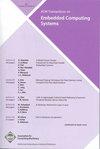BASS: Safe Deep Tissue Optical Sensing for Wearable Embedded Systems
IF 2.8
3区 计算机科学
Q2 COMPUTER SCIENCE, HARDWARE & ARCHITECTURE
引用次数: 0
Abstract
In wearable optical sensing applications whose target tissue is not superficial, such as deep tissue oximetry, the task of embedded system design has to strike a balance between two competing factors. On one hand, the sensing task is assisted by increasing the radiated energy into the body, which in turn, improves the signal-to-noise ratio (SNR) of the deep tissue at the sensor. On the other hand, patient safety consideration imposes a constraint on the amount of radiated energy into the body. In this paper, we study the trade-offs between the two factors by exploring the design space of the light source activation pulse. Furthermore, we propose BASS, an algorithm that leverages the activation pulse design space exploration, which further optimizes deep tissue SNR via spectral averaging, while ensuring the radiated energy into the body meets a safe upper bound. The effectiveness of the proposed technique is demonstrated via analytical derivations, simulations, and in vivo measurements in both pregnant sheep models and human subjects.BASS:用于可穿戴嵌入式系统的安全深层组织光学传感
在目标组织不是表面的可穿戴光学传感应用中,如深层组织血氧测定,嵌入式系统设计的任务必须在两个竞争因素之间取得平衡。一方面,通过增加进入人体的辐射能量来辅助传感任务,这反过来又提高了传感器深层组织的信噪比(SNR)。另一方面,考虑到病人的安全,对进入人体的辐射能量的量施加了限制。本文通过探索光源激活脉冲的设计空间,研究了这两个因素之间的权衡。此外,我们提出了BASS,一种利用激活脉冲设计空间探索的算法,该算法通过频谱平均进一步优化深层组织信噪比,同时确保进入人体的辐射能量满足安全上限。通过分析推导、模拟和怀孕羊模型和人类受试者的体内测量,证明了所提出技术的有效性。
本文章由计算机程序翻译,如有差异,请以英文原文为准。
求助全文
约1分钟内获得全文
求助全文
来源期刊

ACM Transactions on Embedded Computing Systems
工程技术-计算机:软件工程
CiteScore
3.70
自引率
0.00%
发文量
138
审稿时长
6 months
期刊介绍:
The design of embedded computing systems, both the software and hardware, increasingly relies on sophisticated algorithms, analytical models, and methodologies. ACM Transactions on Embedded Computing Systems (TECS) aims to present the leading work relating to the analysis, design, behavior, and experience with embedded computing systems.
 求助内容:
求助内容: 应助结果提醒方式:
应助结果提醒方式:


